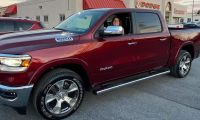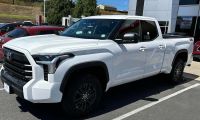A Canadian fleet management company that makes a popular app called MyCarma for use in tracking vehicle usage and conditions has released data that shows warm and cold weather driving habits and range changes for customers using their app.
More than 7,000 trips in the Nissan LEAF were recorded in various weather conditions and used to plot range expectations for the cars. Only about 4,000 Chevrolet Volt data points were recorded, since they excluded trips taken when temperatures were below -4C (25F), since the Volt runs its combustion engine to augment battery thermal management and hence is not in EV-only mode.
The data shows that range loss as temperature leaves the Goldilocks Zone of 15-24 C (60-75F), range losses begin to mount. Batteries using the lithium-ion chemistry common in today's electric vehicles are known to lose performance outside of that temperature zone. Some automakers, like General Motors, chose to use thermal management to help counteract these losses. Others, like Nissan, chose to take the losses and allow an overall average to play out. Whatever the choice, it's one of several factors that contribute to sometimes extreme range losses in EVs when temperatures leave the comfort zone.
As temperatures leave the comfort ranges for both li-ion and humans, not only does that affect how much power the battery can supply, but it also changes how the driver demands that power. More and more of it will be required to heat or cool the cabin. This is also reflected in the FleetCarma (makers of MyCarma) data set as more and more range is sucked away to keep passengers in the car comfortable.
It should be noted that this data includes Volts and LEAFs of current vintage (to 2013). Nissan plans to deploy a more tolerant battery chemistry early next year and GM has made improvements to thermal management that may change things as well. Regardless, these are real-world numbers. You can find the full report at FleetCarma.
Chevrolet Volt Range Changes
Using the data set for the Volt trips recorded, we see a maximum range of around 61 miles when temperatures are between 60 and 70 degrees F. When temperatures drop, the curve quickly goes with it, dropping range to a maximum expectation of about 27 when the temperature is about the same (27F). At the highest temperature point, roughly 90F, we see a maximum range expectation of about 49 miles.
Minimum ranges are on a less harsh curve, but far lower in expectation with the best being, again at 60-70F at around 43 miles and at worst at 27F with about 19 miles of expectation. At the highest temperature on the chart (90F), we see a 39 mile minimum range expectation.
Nissan LEAF Range Changes
In the LEAF, we see a more sinuous curve since temperature ranges are taken to their fullest. At its apex, the maximum expected range was had in the 70F area at about 122 miles. At the lowest end, maximum expected range was about 61 miles at -15F. A maximum range of about 92 miles at 90F was the other end of the chart.
Minimum ranges were on a similar curve. At the best, the range was about 75 miles at around 70F, at worst about 48 miles at -15F. At 90F, minimum range was not much better than that at only 55 miles.
Averages
The average range logged on a Nissan LEAF was 32F at 64 miles and for the Volt it was 32F at 26 miles. The best data point was for the LEAF at 32F with 106 miles of range and for the Volt at 32F it was 38 miles.
In Sum
The minimum and maximum ranges shown give two ends of the driving spectrum. Most drivers, obviously, fell somewhere in the middle. The minimum range was assuming the driver did nothing to promote longer battery life or lower their need for climate controls. The maximums assumed they did everything possible to do those things. On a daily basis, the numbers show, most drivers do something halfway between, doing some things to help range, but not everything possible every time.
The charts also give an indication of how much the weather as well as the driver can affect the range of their electric vehicle. Even if the driver does everything to the maximum, it's clear that weather will still play a big role in the vehicle's range potential. This is one of the issues with batteries that has been understood since chemical batteries became of use in automotive. We all know that our car starts more sluggishly in extreme cold and has less battery life in extreme heat. This is true of both lithium-ion and lead-acid battery makeup. GM learned this early on with their NiMH batteries in the EV1 as well.
Since few people live in climates that hold optimum temperatures for most of the year, the consideration of battery performance in various temperature ranges is very important for both the manufacturer and the potential buyer of an EV. This valuable data from FleetCarma shows numbers common to the northern half of the northern hemisphere (upper United States and Canada). In time, we may have data from equatorial climes as well as the central part of the hemisphere.












Comments
How exactly do you determine
Permalink
How exactly do you determine the range? Is this from the dash mounted "Distance To Empty" readout? Are drivers physically driving the cars to exhaustion? Some other method?
Also, I have a little quibble. Lithium batteries don't lose energy above 25C / 77F degrees. In the LEAF, in particular because it's the only mass market battery EV without thermal management of the battery, the stored energy continues to rise.
RULE OF THUMB
We use 1% increase in stored energy per 4C / 8F above 20C / 70F, and a loss of energy of 1% per 2C / 4F below 20C / 70F. That means that a 20C / 70F battery in a like new condition in the LEAF will have about 21kWh of "usable" stored energy, while at 0C / 32F, it will have 10% less usable stored energy. Conversely, it will have 5% more stored usable energy at 40C / 110F.
What confuses some folks is that temperature controlled cars (other than the LEAF) certainly have reduced range at hotter and colder temperatures merely because the temperature control is consuming energy to keep the battery closer to 20-25C (68F - 77F)
The hotter the battery, the higher it's degradation and service life. The lower temperature batteries have lower energy density but far longer service lives. The intersection of the two lines of degradation referenced to temperature and stored energy also referenced to temperature just happen to intersect around 20C - 25C. That's why temperature controlled cars use this temperature.
Ask the people who did the
Permalink
In reply to How exactly do you determine by Tony Williams (not verified)
Ask the people who did the data collection. Range determination was likely from on-board range estimates from the car's computer.
As for the rest, battery longevity certainly is an important part of all of this.
This is a great story. I
Permalink
This is a great story. I plan to do one soon on Tesla Model S mileage and I will place a link to this as a general reference. Consumer Reports (who is a huge fan of the Tesla) has found that the range drops measurably in cold weather after a year with the car in New England.
Every EV ever made has this
Permalink
In reply to This is a great story. I by John Goreham
Every EV ever made has this issue. BMW found it with the Mini E as did Mitsubishi with the iMiEV. I'm sure even the Detroit winters affected the old Detroit Electrics.
"Only about 4,000 Chevrolet
Permalink
"Only about 4,000 Chevrolet Volt data points were recorded, since they excluded trips taken when temperatures were below -4C (25F), since the Volt runs its combustion engine to augment battery thermal management and hence is not in EV-only mode."
2011 Volts and most 2012 Volts have no engine temperature setting, so it will cycle on and off at 25F or colder ambient temperatures.
The 2013 and newer Volts and some 2012s by default are set at 35F but have a "very cold" option in which the engine will only cycle on and off at temperatures of 15F or colder.
The ONLY reason why the engine does turn on when you still have charge in the battery is to keep the safety companies happy with the speed in which the windows have to defog at. The engine only helps with heat coming through the cabin vents, it does NOT heat the battery directly whatsoever, no engine coolant line or heat exchangers from the engine coolant goes into the battery pack. The battery pack has an 1800 watt resistive heater.
So, there is no need for the engine to come on, let the seat warmers keep you warm and perhaps some light electric heat through the cabin vents.
Also, you can DISABLE the engine in cold temperatures entirely by replacing the ambient temperature sensor with a fixed resistor so the car will always read a value above 35F all the time. It shouldn't screw up anything. There is a seperate air sensor for the engine system.
Google "Dealer resetting the ERDTT to the lower value on 2012s and earlier",
at the bottom post it has a link for a pdf showing instructions on how to do this. Replace sensor with a 1/2watt 15Kohm 5% tolerance resistor. User 'somms' of gm-volt figured this out. If you ever have to service the volt, swap the resistor for the sensor again so no warranty concerns.
Again, this data represents
Permalink
In reply to "Only about 4,000 Chevrolet by danwat1234 (not verified)
Again, this data represents NORMAL owners, not those who do modifications to maximize their range potential or hypermile every minute they're driving the car. Which is the point, since 99% of drivers, even in ICE vehicles, only rarely do those things as well.
Further, most drivers aren't going to sit in a freezing car with just seat warmers and their mittens. Sorry, but that's not how 99% of drivers in cold weather are. Remember: these are REAL WORLD, not hypothetical "if you do all of this, then.." It's also very likely that a large number of the LEAFs in this data set don't have seat warmers as they weren't standard until this year.
Also, the engine coming on does supply power to both the battery and the heat exchange for the batteries in the Volt, which is why they did not include the data.
Normal users can do this, the
Permalink
In reply to Again, this data represents by Aaron Turpen
Normal users can do this, the sensor is accessable from the front grille. Take it out and replace it with a resistor. The bigger the resistor the colder the temperature is detected. Find what works and keep it in there. Done.
With short trips this will help enormously on efficiency. The battery can supply electric heat through the vents, to the battery and to the seats if the car has that feature.
This is not hypothetical, it has been proven. Engine will not come on due to temperature if it thinks it is warm outside, via the ambient temperature sensor signal.
I think you missed my entire
Permalink
In reply to Normal users can do this, the by danwat1234 (not verified)
I think you missed my entire point. NORMAL USERS DO NOT MOD THEIR CARS, even to just add a resistor.
I would like to see the range
Permalink
I would like to see the range numbers for various ICE cars as well for a point of comparison. Weather effects efficiency of all vehicles.
Outside of starting, which
Permalink
In reply to I would like to see the range by Stephen Bieda (not verified)
Outside of starting, which can be a problem thanks to how cold weather affects batteries, gasoline and natural gas engines generally fare better in cold weather. Diesel, not so much, but because of its high compression, once started it warms quickly. Colder air is usually better for ICE intake as it helps regulate temperatures and is usually more dense and has less moisture in it than warm air does.
As with the EV, efficiency largely depends on the driver rather than the engine. Which was one of the biggest points made in this study.